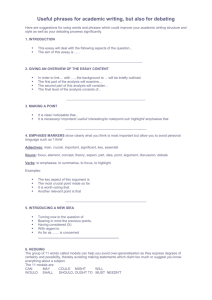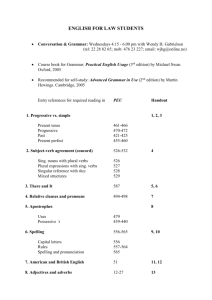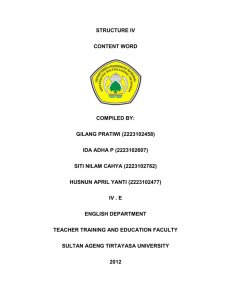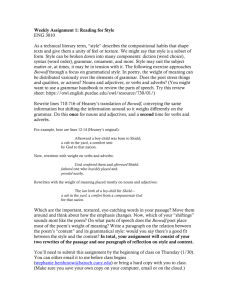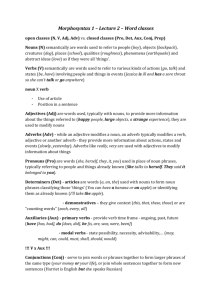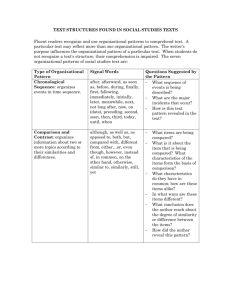4th Opinion Writing Rubric
advertisement
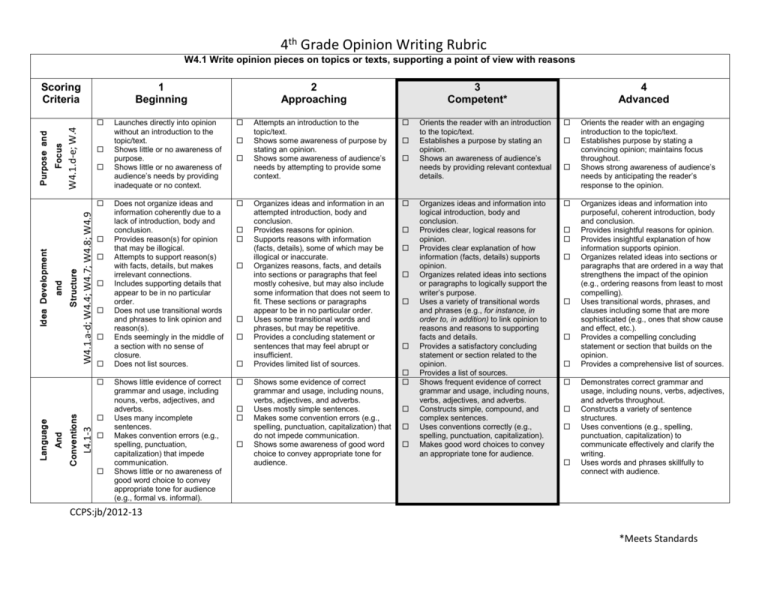
4th Grade Opinion Writing Rubric W4.1 Write opinion pieces on topics or texts, supporting a point of view with reasons Scoring Criteria 1 Beginning W4.1.d-e; W.4 Focus Purpose and W4.1.a-d; W4.4; W4.7; W4.8; W4.9 Structure and Idea Development L4.1-3 Conventions And Language 2 Approaching Launches directly into opinion without an introduction to the topic/text. Shows little or no awareness of purpose. Shows little or no awareness of audience’s needs by providing inadequate or no context. Does not organize ideas and information coherently due to a lack of introduction, body and conclusion. Provides reason(s) for opinion that may be illogical. Attempts to support reason(s) with facts, details, but makes irrelevant connections. Includes supporting details that appear to be in no particular order. Does not use transitional words and phrases to link opinion and reason(s). Ends seemingly in the middle of a section with no sense of closure. Does not list sources. Shows little evidence of correct grammar and usage, including nouns, verbs, adjectives, and adverbs. Uses many incomplete sentences. Makes convention errors (e.g., spelling, punctuation, capitalization) that impede communication. Shows little or no awareness of good word choice to convey appropriate tone for audience (e.g., formal vs. informal). 3 Competent* Attempts an introduction to the topic/text. Shows some awareness of purpose by stating an opinion. Shows some awareness of audience’s needs by attempting to provide some context. Organizes ideas and information in an attempted introduction, body and conclusion. Provides reasons for opinion. Supports reasons with information (facts, details), some of which may be illogical or inaccurate. Organizes reasons, facts, and details into sections or paragraphs that feel mostly cohesive, but may also include some information that does not seem to fit. These sections or paragraphs appear to be in no particular order. Uses some transitional words and phrases, but may be repetitive. Provides a concluding statement or sentences that may feel abrupt or insufficient. Provides limited list of sources. Shows some evidence of correct grammar and usage, including nouns, verbs, adjectives, and adverbs. Uses mostly simple sentences. Makes some convention errors (e.g., spelling, punctuation, capitalization) that do not impede communication. Shows some awareness of good word choice to convey appropriate tone for audience. 4 Advanced Orients the reader with an introduction to the topic/text. Establishes a purpose by stating an opinion. Shows an awareness of audience’s needs by providing relevant contextual details. Organizes ideas and information into logical introduction, body and conclusion. Provides clear, logical reasons for opinion. Provides clear explanation of how information (facts, details) supports opinion. Organizes related ideas into sections or paragraphs to logically support the writer’s purpose. Uses a variety of transitional words and phrases (e.g., for instance, in order to, in addition) to link opinion to reasons and reasons to supporting facts and details. Provides a satisfactory concluding statement or section related to the opinion. Provides a list of sources. Shows frequent evidence of correct grammar and usage, including nouns, verbs, adjectives, and adverbs. Constructs simple, compound, and complex sentences. Uses conventions correctly (e.g., spelling, punctuation, capitalization). Makes good word choices to convey an appropriate tone for audience. Orients the reader with an engaging introduction to the topic/text. Establishes purpose by stating a convincing opinion; maintains focus throughout. Shows strong awareness of audience’s needs by anticipating the reader’s response to the opinion. Organizes ideas and information into purposeful, coherent introduction, body and conclusion. Provides insightful reasons for opinion. Provides insightful explanation of how information supports opinion. Organizes related ideas into sections or paragraphs that are ordered in a way that strengthens the impact of the opinion (e.g., ordering reasons from least to most compelling). Uses transitional words, phrases, and clauses including some that are more sophisticated (e.g., ones that show cause and effect, etc.). Provides a compelling concluding statement or section that builds on the opinion. Provides a comprehensive list of sources. Demonstrates correct grammar and usage, including nouns, verbs, adjectives, and adverbs throughout. Constructs a variety of sentence structures. Uses conventions (e.g., spelling, punctuation, capitalization) to communicate effectively and clarify the writing. Uses words and phrases skillfully to connect with audience. CCPS:jb/2012-13 *Meets Standards



